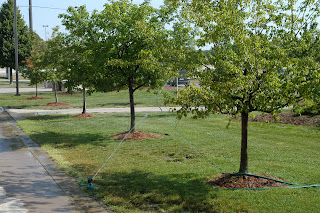July 25, 2012
Next week, I'll put up a blog about watering lawns, but this week I want to concentrate on trees. I am not watering my own lawn and it is crunchy dry. I did spend the weekend, however, watering my young trees and landscape plants. I have a lot of money invested in landscaping and I don't want to lose it.
Here are some thoughts by Dr. Jeff Iles, chair of the Department of Horticulture here at Iowa State. This is his specialty. At the end of Jeff's thoughts, I will include a link to a webinar on watering. It is 90 minutes long and covers everything from tree fruits to landscape plants.
From Dr. Jeff Iles:
Watering Landscape Plants
It’s
dry. Very dry. And it just might stay that way for a
while. So what do we do? Well, we could just close up shop and let our
yards turn to dust, or we could bust out the hoses and prepare for battle. Really folks, let’s be realistic. This drought can’t last forever. But until it begins to rain again, our plants
are depending on us to keep them alive.
Here’s how you can help.
First,
consider the water needs of newly-planted trees and shrubs. Remember, these newcomers to the landscape are
dependent on roots within the rootball (for balled & burlapped plants) or
the root-mass (for container-grown plants) for water uptake and survival. Therefore, the most important place to check
water status (water need) is in the rootball or root-mass, not in the
surrounding backfill soil. Until roots
grow into the backfill soil, moisture in the rootball or root-mass can be
depleted very quickly. This is why frequently irrigated trees and shrubs
will establish more quickly than those receiving infrequent irrigation. Proper frequency and amount of water needed
will vary according to area rainfall, moisture-holding capacity of the soil,
and the site’s drainage characteristics.
But with temperatures hovering around 100-degrees, daily irrigation may
be in order especially for plants on open, exposed sites.
To properly
water newly-installed landscape plants, apply water slowly near the base of the
plant and over the developing root system.
Water applied too rapidly will be lost through run-off. Two to four gallons/inch of trunk diameter is
a good rule of thumb for trees. Irrigation
frequency can be reduced and the area to be watered enlarged as the root system
begins to grow into the backfill and surrounding site soil. A shallow layer (two to four inches) of organic
mulch spread over the planting site will help conserve moisture in the soil. Products like shredded bark and wood chips
also will help water infiltrate the soil rather than run off.
During
extended periods of drought, even large, established trees and shrubs
appreciate a drink from the garden hose.
A single, large tree can transpire away more than 100 gallons of water
on a typical summer day. If your plants
are showing symptoms of moisture stress (wilting, yellow leaves, and/or
scorched leaves) apply water with an oscillating sprinkler set at low pressure
(preferably when winds are calm) until the soil is wet to a depth of 18
inches.
Apply
water to an area at least as wide as the branch spread. Well-established plants often have extensive
root systems that extend far beyond the tips of the branches and will benefit
from water applied to the soil outside the branch spread.
Jeff Iles
Department of Horticulture
Iowa State University
Here is the link to the webinar on the drought. It includes information from several extension people at ISU about the drought.



No comments:
Post a Comment